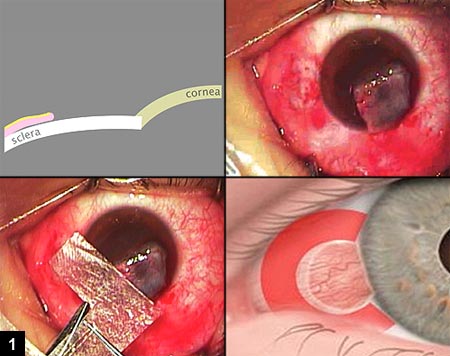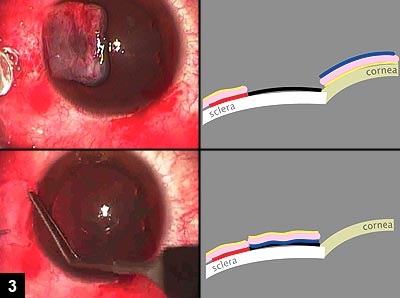Amniotic membrane transplant key to pterygium surgical method
Technique may provide a more prolonged antifibrotic effect and a decreased recurrence rate, but further study is needed.
Introduction
There is a continued search among ophthalmic surgeons for the optimal surgical technique for pterygium surgery. This is partly because pterygium surgery is associated with potential postoperative complications, including recurrence of pterygium.
 |
My guests in this corneal dissection column, John A. Hovanesian, MD, FACS, and Andrew Behesnilian, BS, describe their surgical technique of using amniotic membrane transplantation as a “biologic implant” beneath the normal conjunctiva surrounding the region where the pterygium is excised and replaced with a conjunctival autograft. They said the recurrence rate of 5% after pterygium surgery combined with conjunctival autograft is similar to the eyes receiving amniotic membrane transplantation in the region where the pterygium is excised. The guests are of the opinion that placing the amniotic membrane graft in the surgically created subconjunctival space may provide a more prolonged antifibrotic effect, as compared with placing it on the ocular surface, and may contribute to a decreased recurrence rate of the pterygium. This technique must be further examined in larger studies to address all of the ocular effects of such a procedure.

The preferred anesthesia for this technique is with a peribulbar block of bupivacaine and lidocaine 1% with epinephrine. Although subconjunctival infiltration of anesthetic agents is also effective for the procedure, this may result in more postoperative patient discomfort.
Step-by-step surgery
Fibrin tissue adhesive (Tisseel, Baxter AG) is reconstituted according to the manufacturer’s instructions, but the components are not transferred to the supplied Duploject syringe. Instead, they are left in their original vials. The pterygium is excised along with an additional 1-mm margin of conjunctival tissue, thus exposing the bare sclera (Figure 1). Next, blunt Westcott scissors are used to create a potential space of about 5 mm beneath the healthy conjunctiva on the three sides surrounding the site of pterygium excision. This potential space should be superficial to most of Tenon’s fascia, the medial rectus muscle and tendon. Minimal cautery is used to establish hemostasis. Next, a thin conjunctival autograft similar in size to the conjunctival defect that was created after pterygium excision is prepared from the superior bulbar conjunctiva of the same eye. At this point, the graft is left attached (Figure 1) at the limbus superiorly, such that it is not misplaced during the subsequent surgical steps.
 Schematic representation displaying the bare sclera after pterygium excision. Conjunctiva is shown in pink, with a yellow line on its epithelial side (upper left); The pterygium has been excised and the autograft prepared and reflected onto the cornea at the superior limbus (upper right); Freeze-dried human amniotic membrane is cut into a C-shaped graft (lower left); The amniotic membrane is placed in the subconjunctival region surrounding the site of pterygium excision. The location of the amniotic membrane graft is shown in red, surrounding the area where the conjunctival autograft will be placed (lower right). Images: Hovanesian JA |
Amniotic membrane preparation: Freeze-dried human amniotic membrane, namely AmbioDry2 (IOP Inc.), in its dry form is removed from the outer packaging, but it is left in its inner packaging. The amniotic membrane is then cut through the packaging into a C-shaped graft that is large enough to surround the conjunctival defect (Figure 1).
Fibrin adhesive preparation: A sterile 1-cc syringe with an 18-gauge needle is used to aspirate 0.1 cc of the fibrinogen in a sterile fashion from the fibrin sealant vial (blue label). Similarly, 0.1 cc of thrombin is aspirated into a separate 1-cc syringe from the thrombin sealant vial (black label). Air entry into these syringes is minimized. Next, into the thrombin-filled syringe, 0.9 cc of balanced salt solution is added, and the syringe is inverted several times to facilitate mixing. The adhesive components are now ready for use.
Amniotic membrane application: A few drops of sterile balanced salt solution are placed on the bare sclera that will allow for the subsequent hydration of the freeze-dried amniotic membrane and facilitate its sliding on the ocular surface. The cut-edge of the conjunctiva is lifted using 0.12 forceps, and a Paton spatula containing a small droplet of fibrinogen is introduced. The fibrinogen is applied to the undersurface of the conjunctiva that was tented-up. This fibrinogen will help keep the amniotic membrane in place upon its introduction into this surgically created potential space in the subconjunctival region. Thrombin is not applied at this time. Attention is directed back to the amniotic membrane graft, which is removed from its packaging and placed on the bare sclera. Using non-toothed, smooth forceps, the amniotic membrane is then gently grasped and brought into the subconjunctival space (Figure 2). The amniotic membrane is evenly distributed in this space. However, some amniotic membrane folds may remain, which usually have no postoperative deleterious effects on the overall outcome of this surgical procedure. The goal is to create a subconjunctival amniotic membrane “belt-way” that surrounds the area of the bare sclera, not to cover the bare sclera (Figures 1 and 2). After placing the amniotic membrane in the subconjunctival space, the edges of the overlying conjunctiva are lifted and advanced toward the limbus to cover any remnants of amniotic membrane transplantation that are exposed. The presence of the fibrinogen, mixed with small amounts of thrombin in the patient’s own blood, will allow these edges to stay in place, covering all of the amniotic membrane transplantation.
 The graft is tucked into the subconjunctival space to provide its antifibrotic effects to Tenon’s fascia, from which pterygium recurrence might arise (upper left); Amniotic membrane (red) does not cover the bare-scleral defect (upper right); From the superior limbus, the conjunctival autograft is cut free from the superior limbus (lower left); The free conjunctival autograft is inverted on the cornea (note yellow epithelial surface of graft shown against the corneal epithelium) and oriented limbus-to-limbus adjacent to the excision site (lower right). |
Application of conjunctival autograft: The conjunctival autograft, which remains attached to the superior limbus, is now reflected onto the cornea (epithelium to epithelium) and cut free from the superior limbus with scissors (Figure 2). The surgeon slides this graft across the cornea, orienting its limbal side to the limbus where the pterygium was excised (Figure 3). A small droplet from the diluted thrombin syringe (black label) is applied to the bare sclera (Figure 3), and a small droplet from the fibrinogen (blue label) syringe is applied to the underside of the graft. The graft is then grasped with two MacPherson forceps and flipped onto the bare sclera. This allows the two adhesive components to mix, and the surgeon has about 30 seconds to manipulate and orient the graft appropriately, such that the edges of the graft are approximated with the cut-edges of the surrounding conjunctiva and the corneal margin is aligned with the limbus (Figure 3).
 Thrombin (black label vial) diluted with balanced salt solution is placed on the excision site, and fibrinogen (blue label vial) is placed on the stromal side of the autograft (upper row); The conjunctival autograft is inverted, mixing the adhesive components, and smoothed to approximate the edges of conjunctiva (lower row). |
Surgical pearls and tips
- Conservative use of cautery avoids postoperative pain and is usually sufficient, as the fibrin adhesive provides additional hemostasis.
- Dilution of one part thrombin with nine parts balanced salt solution slows the polymerization process with fibrin adhesive and allows more time for manipulation of the graft.
- Harvesting a thin conjunctival autograft is best accomplished by making a small opening in the conjunctiva distal to the limbus and then lifting the cut-edge of the conjunctiva (with minimal Tenon’s membrane) using toothed forceps. Blunt Westcott scissors can be inserted parallel to the conjunctival surface and then opened in the plane just below the conjunctiva to separate it away from the underlying tissues, namely most of Tenon’s membrane.
- The conjunctival autograft should match the size of the conjunctival opening after pterygium excision and should not be significantly oversized or contain excessive Tenon’s membrane to avoid any significant tissue swelling after surgery.
- Once the conjunctival autograft is in place covering the bare sclera with its edge properly approximated (as described above) and the two components of the fibrin glue begin to mix, the surgeon should avoid unnecessary touching of the graft or surrounding conjunctiva, as this will usually weaken the “bonds” of the fibrin adhesive and may result in suboptimal attachment of the conjunctival autograft.
- During the postoperative follow-up period, a small gap at the nasal edge of the graft may occasionally occur. This does not increase the risk of recurrence of the pterygium.
Treatment
Postoperative follow-up and drug regimen: Zymar ophthalmic solution (gatifloxacin, Allergan), one drop four times a day, and Xibrom (bromfenac ophthalmic solution, Ista Pharmaceuticals), one drop twice a day, are used for 1 week after surgery. Pred Forte 1% drops (prednisolone acetate, Allergan) are used four times a day for 2 weeks, and then tapered off over the following 2 weeks.
For more information:
- John A. Hovanesian, MD, FACS, is a clinical instructor at the UCLA Jules Stein Eye Institute and is in private practice in Laguna Hills, Calif. He can be reached at Harvard Eye Associates, 24401 Calle De La Louisa, Suite 300, Laguna Hills, CA 92653; 949-951-2020; fax: 949-380-7856; e-mail: drhovanesian@harvardeye.com. Dr. Hovanesian is a consultant to Allergan, Baxter AG, IOP Inc. and Ista Pharmaceuticals.
- Thomas John, MD, is a clinical associate professor at Loyola University at Chicago and is in private practice in Tinley Park and Oak Lawn, Ill. He can be reached at 708-429-2223; fax: 708-429-2226; e-mail: tjcornea@gmail.com. Dr. John has no direct financial interest in the products discussed in this article, nor is he a paid consultant for any companies mentioned.
References:
- Chui J, Di Girolamo N, Wakefield D, Coroneo MT. The pathogenesis of pterygium: Current concepts and their therapeutic implications. Ocul Surf. 2008;6:24-43.
- De la Hoz F, Montero JA, et al. Efficacy of mitomycin C associated with direct conjunctival closure and sliding conjunctival graft for pterygium surgery. Br J Ophthalmol. 2008;92:175-178.
- Hovanesian JA, Behesnilian A. Results of pterygium excision using amniotic membrane beneath the healthy conjunctiva surrounding a conjunctival autograft. Presented at: Annual Meeting of the American Society of Cataract and Refractive Surgery; 2008; Chicago.
- Kenyon KR, Wagoner MD, Hettinger ME. Conjunctival autograft transplantation for advanced and recurrent pterygium. Ophthalmology 1985;92:1461-1470.
- Ma DH, See LC, Liau SB, Tsai RJ. Amniotic membrane graft for primary pterygium: Comparison with conjunctival autograft and topical mitomycin C treatment. Br J Ophthalmol. 2000;84:973-978.
- Memarzadeh F, Fahd AK, Shamie N, Chuck RS. Comparison of de-epithelialized amniotic membrane transplantation and conjunctival autograft after primary pterygium excision. Eye. 2008;22:107-112.
